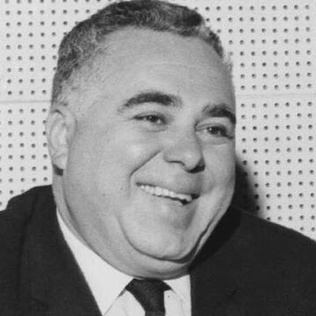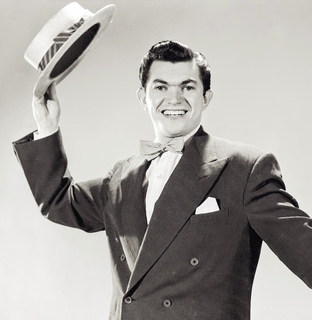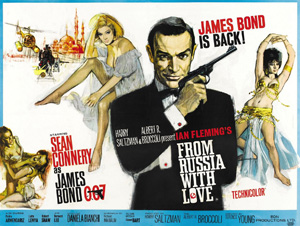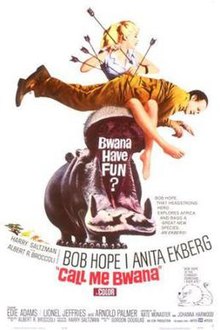
Felix Leiter is a fictional character created by Ian Fleming in the James Bond books, films and other media. The character is an operative for the CIA and Bond's friend. After losing a leg and his hand to a shark attack, Leiter joined the Pinkerton Detective Agency. The name "Felix" comes from the middle name of Fleming's friend Ivar Bryce, while the name "Leiter" was the surname of Fleming's friend Marion Oates Leiter Charles, the then wife of Thomas Leiter.

Albert Romolo Broccoli, nicknamed "Cubby", was an American film producer who made more than 40 motion pictures throughout his career. Most of the films were made in the United Kingdom and often filmed at Pinewood Studios. Co-founder of Danjaq, LLC and Eon Productions, Broccoli is most notable as the producer of many of the James Bond films. He and Harry Saltzman saw the films develop from relatively low-budget origins to large-budget, high-grossing extravaganzas, and Broccoli's heirs continue to produce new Bond films.

Eon Productions Limited is a British film production company that primarily produces the James Bond film series. The company is based in London's Piccadilly and also operates from Pinewood Studios in the UK.

Kerstin Anita Marianne Ekberg was a Swedish actress active in American and European films, known for her beauty and curvy figure. She became prominent in her iconic role as Sylvia in the Federico Fellini film La Dolce Vita (1960). Ekberg worked primarily in Italy, where she became a permanent resident in 1964.

Herschel "Harry" Saltzman was a Canadian theatre and film producer. He is best remembered for co-producing the first nine of the James Bond film series with Albert R. Broccoli. He lived most of his life in Denham, Buckinghamshire, England.
Peter Roger Hunt was a British director, editor and producer of film and television, best known for his work on the James Bond film series, first as an editor and then as a second unit director. He finally served as director for On Her Majesty's Secret Service. His work on the series helped pioneer an innovative, fast-cutting editing style.

Monty Norman was a British film score composer and singer. A contributor to West End musicals in the 1950s and 1960s, he is best known for composing the "James Bond Theme", first heard in the 1962 film Dr. No. He was an Ivor Novello Award and Olivier Award winner, and a Tony Award nominee.
Since its inception in 1962, the James Bond film series from Eon Productions has featured many musical compositions, many of which are now considered classic pieces of British film music. The best known piece is the "James Bond Theme" composed by Monty Norman. Other instrumentals, such as "On Her Majesty's Secret Service", and various songs performed by British or American artists such as Shirley Bassey's "Goldfinger", Nancy Sinatra's "You Only Live Twice", Paul McCartney's "Live and Let Die", Carly Simon's "Nobody Does It Better", Sheena Easton's "For Your Eyes Only", Duran Duran's "A View to a Kill", Tina Turner's "GoldenEye" also become identified with the series.
Ted Moore, BSC was a South African-British cinematographer known for his work on seven of the James Bond films in the 1960s and early 1970s. He won the Academy Award for Best Cinematography for his work on Fred Zinnemann's A Man for All Seasons, and two BAFTA Awards for Best Cinematography for A Man for All Seasons and From Russia with Love.

Casino Royale is a 1967 spy parody film originally distributed by Columbia Pictures featuring an ensemble cast. It is loosely based on the 1953 novel of the same name by Ian Fleming, the first novel to feature the character James Bond.

The Man with the Golden Gun is a 1974 spy film and the ninth in the James Bond series produced by Eon Productions, and the second to star Roger Moore as the fictional MI6 agent James Bond. A loose adaptation of Ian Fleming's posthumously published 1965 novel of the same name, the film has Bond sent after the Solex Agitator, a breakthrough technological solution to contemporary energy shortages, while facing the assassin Francisco Scaramanga, the "Man with the Golden Gun". The action culminates in a duel between them that settles the fate of the Solex.

On Her Majesty's Secret Service is a 1969 spy film and the sixth in the James Bond series produced by Eon Productions. It is based on the 1963 novel by Ian Fleming. Following Sean Connery's decision to retire from the role after You Only Live Twice, Eon selected George Lazenby, a model with no prior acting credits, to play the part of James Bond. During filming, Lazenby announced that he would play the role of Bond only once. Connery returned to portray Bond in 1971's Diamonds Are Forever.

The Spy Who Loved Me is a 1977 spy film, the tenth in the James Bond series produced by Eon Productions. It is the third to star Roger Moore as the fictional secret agent James Bond. The film co-stars Barbara Bach and Curt Jürgens and was directed by Lewis Gilbert. The screenplay was by Christopher Wood and Richard Maibaum, with an uncredited rewrite by Tom Mankiewicz.

Dr. No is a 1962 spy film directed by Terence Young. It is the first film in the James Bond series. Starring Sean Connery, Ursula Andress, Joseph Wiseman and Jack Lord, it was adapted by Richard Maibaum, Johanna Harwood, and Berkely Mather from the 1958 novel of the same name by Ian Fleming. The film was produced by Harry Saltzman and Albert R. Broccoli, a partnership that continued until 1975. It was followed by From Russia with Love in 1963. In the film, James Bond is sent to Jamaica to investigate the disappearance of a fellow British agent. The trail leads him to the underground base of Dr. Julius No, who is plotting to disrupt an early American space launch from Cape Canaveral with a radio beam weapon.

From Russia with Love is a 1963 spy film and the second in the James Bond series produced by Eon Productions, as well as Sean Connery's second role as MI6 agent 007 James Bond.
The James Bond film series is a British series of spy films based on the fictional character of MI6 agent James Bond, "007", who originally appeared in a series of books by Ian Fleming. It is one of the longest continually running film series in history, having been in ongoing production from 1962 to the present. In that time, Eon Productions has produced 25 films as of 2021, most of them at Pinewood Studios. With a combined gross of over $7 billion, the films produced by Eon constitute the fifth-highest-grossing film series. Six actors have portrayed 007 in the Eon series, the latest being Daniel Craig.

Dr. No is the film score for the 1962 film of the same name composed by Monty Norman.
Warwick Films was a film company founded by film producers Irving Allen and Albert R. Broccoli in London in 1951. The name was taken from the Warwick Hotel in New York where Broccoli and his wife were staying at the time of the final negotiations for the company's creation. Their films were released by Columbia Pictures.
The following outline is provided as an overview of and topical guide to James Bond:
Johanna Harwood, a.k.a. J. M. Harwood, is a retired Irish screenwriter. She was born and raised in County Wicklow, Ireland. She co-wrote two James Bond films, and went uncredited for adaptation work on a third.













